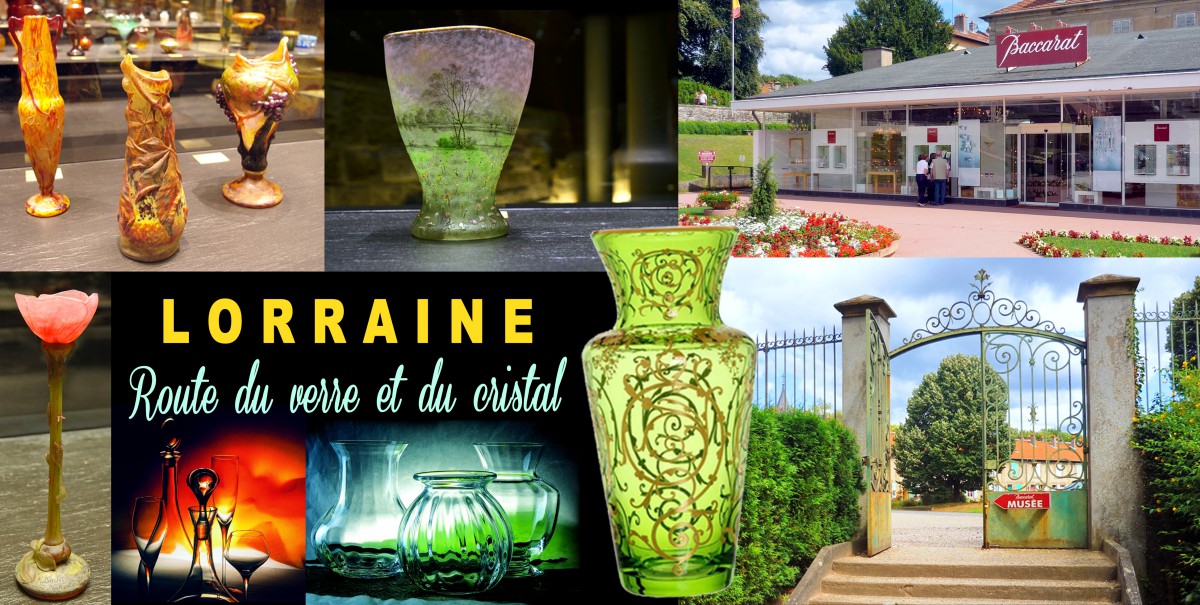The glass and crystal route links all the major glass and crystal works in Lorraine and the Northern Vosges. It shows a unique artistic heritage with international acclaim. If I mention the names of Daum, Baccarat, Lalique. Sound familiar? Well I guess so. And if not, here is a great opportunity to know more about these venerable manufactures. By following this itinerary you will discover the incredible creativity of craftsmen from Lorraine. Pieces of art that have been popular across the world. Crystals that found themselves at the palaces of the Czar Nicolas II, the Queen of England and the Emperor of Japan.
About the glass and crystal industry in Lorraine
https://www.youtube.com/watch?v=Zht-64qQ3tI
The glass industry has been active for a very long time in Lorraine. In the Middle-Ages, many glass works were found in the forested lands in the South of the region, on the borders with Champagne and Franche-Comté. As trading practices evolved these glass making sites declined by the end of the Middle-Ages. Relations between the nomadic glass makers and the Dukes of Lorraine had become rather complicated.
The development of glass works in Lorraine
From the 17th century a new wave of glass industry appeared on the borders of Lorraine and Alsace. In the Middle Vosges (East of Sarrebourg) and particularly in the Northern Vosges (Pays de Bitche). The landowners thought to monetise their immense forested lands by setting up an industry that could use the wood (which often was spoiled and did not make any money).
A few years before the French Revolution (1789), a few glass works discovered the secret of crystal making which had been kept by England since 1676. The royal crystal works of Saint-Louis in Saint-Louis-lès-Bitche is a good example of this!
Today only a few glass works are still active. Leading names from the luxury industry (Baccarat, Lalique, Saint-Louis) contribute to the touristic fame of the region.
The glass industry in the Vosges
What can explain such a concentration of glass and crystal works in the Northern Vosges? And particularly in the former County of Bitche?
The glass works of Lorraine show how strong is the link between the natural environment and human activity. What do you need to make glass? Silica (from sandstone), water and saline (from potash). Wood was used as fuel. It is not surprising to learn that all these ingredients are found abundantly in the Northern Vosges.
Glass or crystal?
What makes crystal different from mere glass? Simple answer: the inclusion of lead oxide. This adds to the material a sparkling glow. It will be easier to work with because the melting point of crystal is below the melting point of glass. Moreover, the expert hands of the master glass makers will do the trick!
The glass and crystal Route in Lorraine
To trace the Glass and Crystal Route, I first identified the main glass and crystal works in Lorraine. Here is the list:
- Daum Crystal works (site)
- Portieux Glass works (site)
- Baccarat Crystal works (site)
- Former glaziery of Cirez-sur-Vezouve
- Former glass works of Saint-Quirin
- Former crystal works of Hartzviller (site)
- Vallérysthal Crystal works (site)
- Crystals Lehrer (site)
- Lalique Crystal works (site)
- Glass-making site of Meisenthal (site)
- Montbronn Crystal works
- Saint-Louis Crystal works (site)
- Former glass works of Gœtzenbruck
- Former crystal works of Lemberg
- Out-of-route: glass and crystal works of Vannes-le-Châtel (site)
Then, I worked on an itinerary to link the main sites. Apart from Nancy and Vannes-le-Châtel, they are all located in Eastern Lorraine by the Vosges. A beautiful 225 kms-long trip to look forward from Nancy to Bitche.
As you may have noticed, I deliberately planned a little detour in Alsace. I could not omit to mention the Lalique crystal works in Wingen-sur-Moder, at the border with Lorraine.
In order to take your time along the Glass and Crystal Route I recommend staying two or three nights near Sarrebourg and Bitche. If you want to visit the many museums, towns, touristic sites found in the Pays de Sarrebourg and Pays de Bitche, stay five to seven days.
Starting point: Nancy and Daum crystals
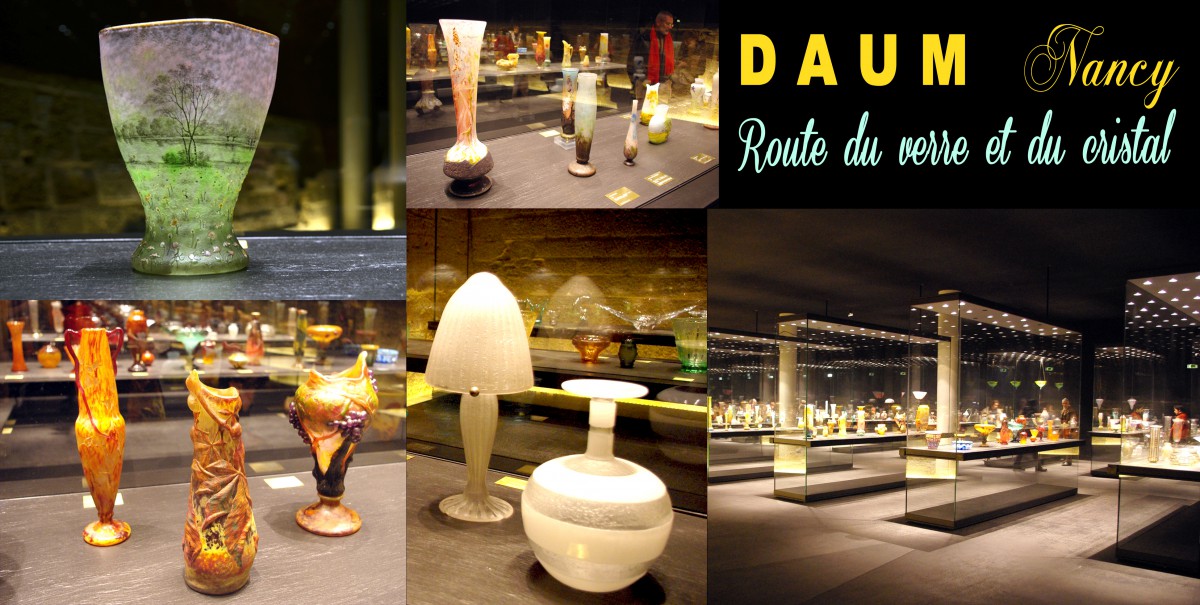
Our 225 kms-long journey across Eastern Lorraine starts in Nancy. There, on the famous place Stanislas are found two major points of interest for Daum Nancy fans: the store (number 14 on the square) and the fantastic collection in the basement of the Fine Arts museum.
A short history of Daum
The Compagnie française du cristal Daum was founded in Nancy in 1878 by Jean Daum, a notary from Bitche. On his death, his sons Auguste and Antonin took over the business and fully embraced a new artistic movement: Art Nouveau. The crystal works’ reputation was assured with the adaptation of its collections to Art Deco in the 1920s.
Exit Nancy via the A330 in the direction of Epinal. At Flavigny-sur-Moselle, leave the motoway and take the D570. The road follows the canal de l’Est with picturesque views. At Charmes, cross the River Moselle and take the D32 to Portieux. Then, follow the D87 to reach the glass works site.
The Portieux glass works
(55 kms from Nancy)
![Portieux crystals © Chaanara - licence [CC BY-SA 4.0] from Wikimedia Commons](https://frenchmoments.eu/wp-content/uploads/2018/06/Portieux-Ritz-©-Chaanara-licence-CC-BY-SA-4.0-from-Wikimedia-Commons.jpg)
The Portieux glass works was founded in 1690 by François Magnien, maître d’hôtel of the Duke of Lorraine. Situated near Charmes, the manufacture was once one the largest employer of the Vosges département with over 1,000 workers. Its activity grew rapidly following the annexation of the Moselle département by Germany in 1871. Consequently the glass works merged with the crystal works of Vallérysthal (see below).
The Portieux glass works is still active today and focuses in hollow glass and decorative items. Some of its famous Parisian clients include Maxim’s, Brasserie Lipp and Crillon Hotel.
On 160m2, the crystal museum display the glass tooling and the working techniques of the glass markets.
Find out more:
- the official website of the glass works
- la cristallerie de Portieux : trois siècles de tradition on the blog MV bracelet [French]
Reach the D32 and take the direction of Rambervillers. Cross the little town and follow the D435 (which becomes the D935 in Meurthe-et-Moselle) until Baccarat.
The Baccarat crystal works
(90 kms from Nancy)
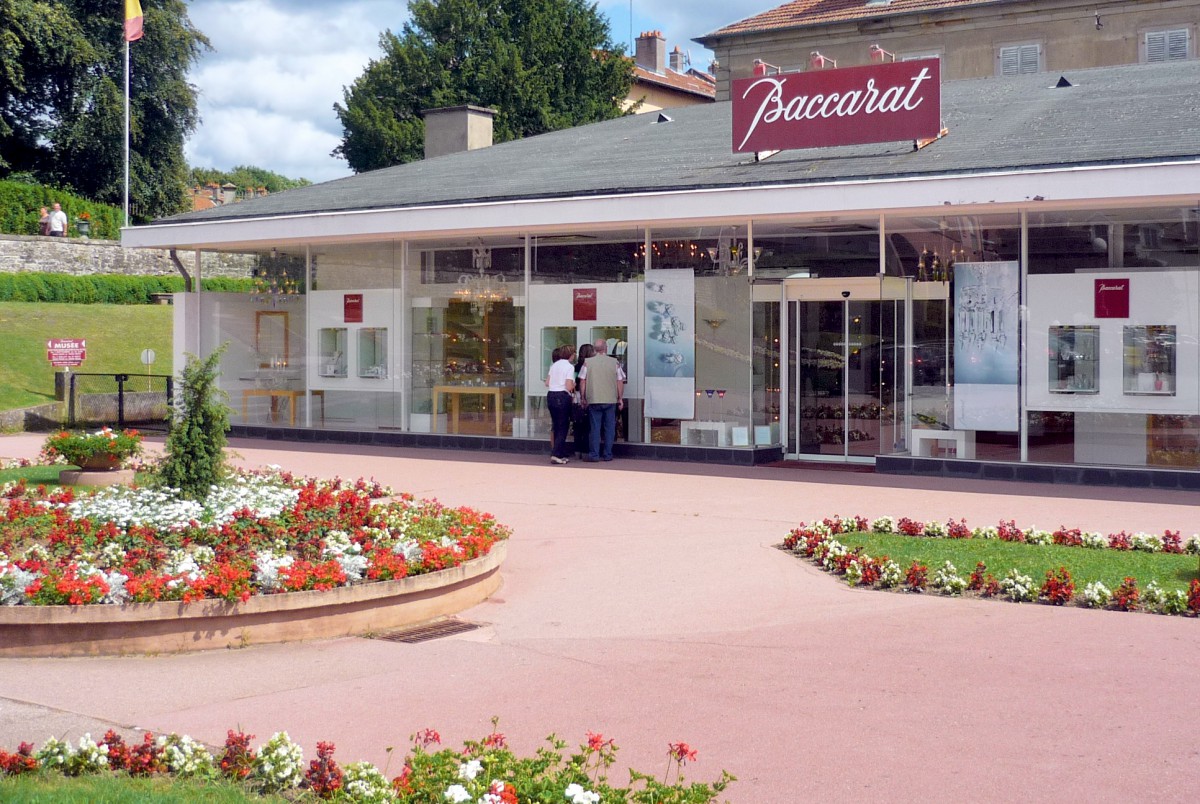
Baccarat is a key stage along the Glass and Crystal Route! This name refers to the French refinement known across the world. In order to discover the history of Baccarat, you have to come to… Baccarat! A little town in the département of Meurthe-et-Moselle, South of Lunéville.
In Baccarat I recommend visiting the crystal museum. The Baccarat museum displays 700 crystal items. You’ll be stunned at the crystal chandelier, table sets, crystal furniture, perfume bottles, candy boxes, clipboards… so many pieces of art hand-engraved with vintage decorative motifs.
Find out more (official website)
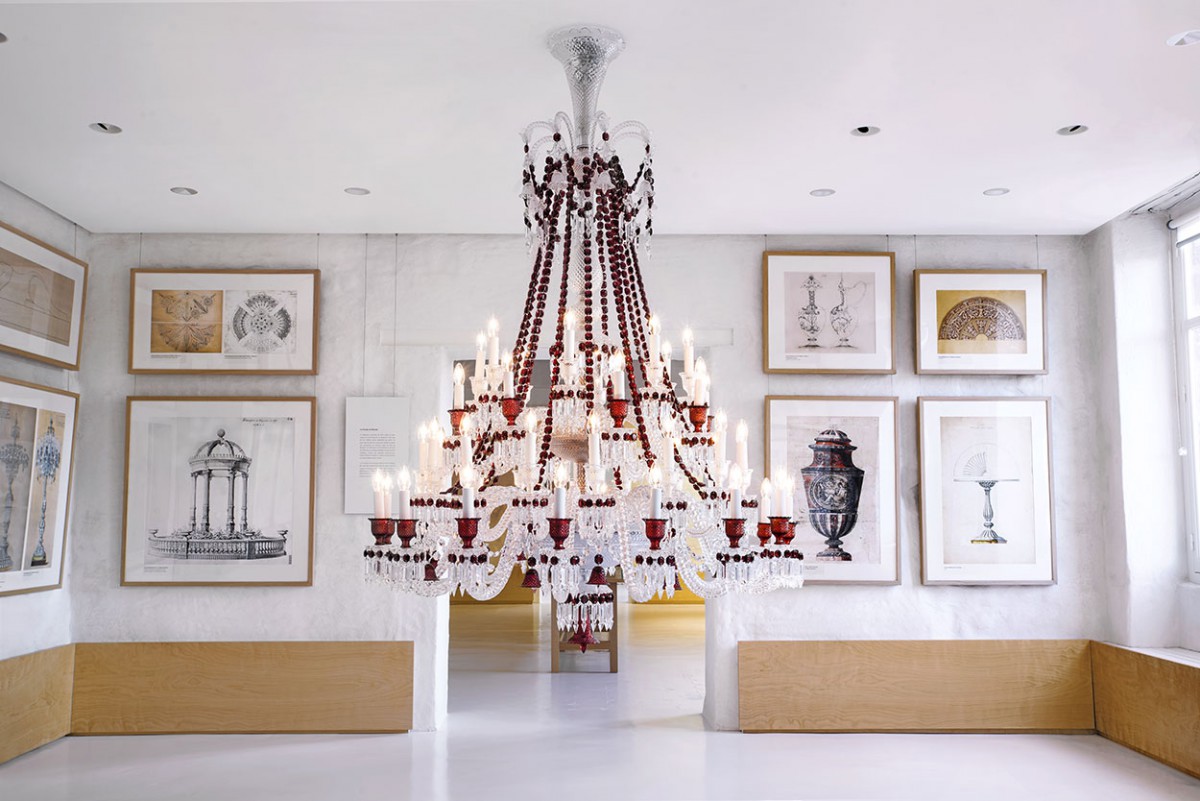
Before leaving Baccarat, indulge yourself with window-shopping at the Baccarat store to admire the contemporary collections.
Across the street is found another historic store: the cristallerie Vessière Cristaux. Since 1882, Vessière Cristaux has been known as the crystal specialist. Enter the store to marvel at Baccarat crystals and discover the great classics of Lalique and Daum.
Take the D935 in the direction of Sarrebourg/Badonviller. At the village of Montigny, turn right (D92) towards Badonviller (a village set against the foothills of the Vosges). take the D8 until Cirey-sur-Vezouze, a little town where a famous glaziery was founded in 1801.
The former glaziery of Cirey-sur-Vezouze
(118 kms from Nancy)
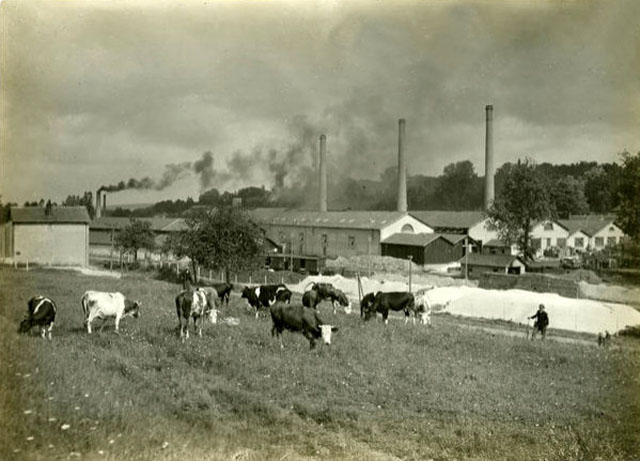
In the past, Cirey-sur-Vezouze was home to a glaziery which was founded around 1760. The manufacture was specialised in the making of mirror glass. Circa 1840 the company was acquired by the société Jean-Auguste Chevandier et Cie. which owned the glass works in Saint-Quirin (see below) and Monthermé (in the Ardennes). Then, in 1848 the glass works were bought by the Manufactures de Saint-Gobain. After being expanded in the 1930s, the factory finally closed its doors in 1939. However the glazing activity in Cirey is not over yet: a glass and glazing company still operate there today.
The crystal works in the Pays de Sarrebourg
The Glass and Crystal Route now criss-crosses the Pays de Sarrebourg. The region accounted for many glass and crystal manufactures, most of them found in the East near the border of Lorraine and Alsace: Saint-Quirin, Hartzviller, Vallérysthal, Lehrer…
Take the D993 in the direction of Saint-Quirin. Stop for a moment in the village, listed as one of France’s most beautiful villages. Continue driving towards Abreschviller (D96). Having crossed the forest, you’ll reach the hamlet of Lettenbach, the former site of the Saint-Quirin glass works.
The former glass works of Saint-Quirin
(131 kms from Nancy)

There is every reason to believe that the Saint-Quirin glass works was one of the oldest in Lorraine (15th century). It was a “roaming” glass works. Workers moved from one site to another where the wood supply was exhausted.
The Saint-Quirin glass works was founded in 1737 on the site of Lettenbach. Qualified workers were brought from Bohemia to launch the crystal production. After a period of prosperity (1740-1770), the glass works closed its doors for good in 1888.
L’église des Verriers de Lettenbach
![Lettenbach, church of the glass makers © François Philipp - licence [CC BY 2.0] from Wikimedia Commons](https://frenchmoments.eu/wp-content/uploads/2018/06/Lettenbach-Eglise-des-Verriers-©-François-Philipp-licence-CC-BY-2.0-from-Wikimedia-Commons.jpg)
The last surviving remain of the former glass manufacture is the Glass makers church in Lettenbach. The sanctuary was built in 1756 for the needs of the workers and their families. It is topped with a fine little onion dome which refers to the Bohemian origins of the workers.
Follow the Glass and Crystal Route and head to Aberschviller (D96) then the D44c and D44a towards Hartzviller.
The former crystal works of Hartzviller
(143 kms from Nancy)
From 1932 to 2004, the crystal works of Hartzviller designed hand-blown glasses. Until its closure, it was one of the last manufactures in France to work in an artisanal and non-mechanised way.

The crystal manufacture provided famous hotels and restaurants with personalised glass-items in small volumes. Clients included the Ritz, the Plaza-Athénée, the Crillon, and restaurant Pierre Gagnaire…
Find out more (official website)
Follow the D96D for 2 kms until Vallérysthal.
The Vallérysthal crystal works
(145 kms from Nancy)
The Vallérysthal crystal works was based on the current site in 1830. In 1872 it merged with the Portieux glass works. Today the production of crystals is still hand-blown. The workshop can be visited with demonstrations by the skilled-workers of the factory.
Find out more (official website)
Reach the D45 by the D96. Turn right in the direction of Lutzelbourg. In the vicinity of the Lehrer crystal works, discover one of the most surprising sites in Lorraine: the canal inclined plane of Saint-Louis-Arzviller.
![The Saint-Louis-Arzviller inclined plane © Gzen92 - licence [CC BY-SA 3.0] from Wikimedia Commons](https://frenchmoments.eu/wp-content/uploads/2018/06/Plan-incliné-de-Saint-Louis-Arzviller-©-Gzen92-licence-CC-BY-SA-3.0-from-Wikimedia-Commons.jpg)
It is a boat lift which allows the Marne-Rhine canal to cross the Vosges mountains in the region of the Saverne Pass.
The crystal from Lehrer
(157 kms from Nancy)
In 2010 the master crystal cutter Bruno Lehrer opened a store in the touristic region of Dabo. Beneath the famous canal inclined plane, the store offers demonstrations of crystal hand-blowing. This is a very popular attraction along the Glass and Crystal Route.
Apart from the production of glass sets, vases and decorative items, the manufacture specialises in lamps of different colours and shapes.
Find out more (official website)
Reach Lutzelbourg by the D98. The village is set in a picturesque site dominated by the ruins of its castle.
![Lutzelbourg castle © Gzen92 - licence [CC BY-SA 4.0] from Wikimedia Commons](https://frenchmoments.eu/wp-content/uploads/2018/06/Château-de-Lutzelbourg-©-Gzen92-licence-CC-BY-SA-4.0-from-Wikimedia-Commons.jpg)
Take the D38 until Phalsbourg. You can stop a moment to discover the little town fortified by Vauban on the borders of Alsace and Lorraine. Cross the Place d’Armes and have a look at the fortifications (Gate of France and Gate of Germany).
From Phalsbourg to the Northern Vosges
![Phalsbourg © Mossot - licence [CC BY 3.0] from Wikimedia Commons](https://frenchmoments.eu/wp-content/uploads/2018/06/Porte-de-France-Phalsbourg-©-Mossot-licence-CC-BY-3.0-from-Wikimedia-Commons.jpg)
The next portion of the Glass and Crystal Route leads you into the Northern Vosges, on the border of Lorraine and Alsace. You’ll cross a small part of the Bas-Rhin département in Alsace before entering into the Pays de Bitche. This region has the strongest concentration of glass and crystal works, hence its nickname: Pays du Verre et du Cristal.
From Phalsbourg take the D104/D133 until Oberhof. Take the D178 to the left in the direction of La Petite-Pierre. This old fortified town deserves a stop.
Reach Wingen-sur-Moder by the D135.
The Lalique crystal works
(190 kms from Nancy)

On the way to Bitche, one could cross the peaceful village of Wingen-sur-Moder without realising that this is the home to one of the most prestigious French luxury manufactures: Lalique! The company is renown for its emblematic vases and its collaboration with luxury brands and world-famous designers. Lalique is characterised by an on-going research for artistic materials used in the design of quality crystal pieces.
The founder, René Jules Lalique (1860-1945) was inspired by beautiful things taken from the daily life to create innovating pieces of art: luminaires, furniture, jewels and perfume bottles. All of them have been designed in the crystal works of Wingen-sur-Moder since 1921.
The Lalique museum
![Coffret en verre Monnaie du pape par René Lalique © licence [CC0] from Wikimedia Commons](https://frenchmoments.eu/wp-content/uploads/2018/06/Coffret-en-verre-Monnaie-du-pape-par-René-Lalique-©-licence-CC0-from-Wikimedia-Commons.jpg)
When stopping at Wingen-sur-Moder, take the time to admire some of the most beautiful creations by Lalique. The Lalique museum displays some 650 items which belonged to René Lalique and its successors. The museum is organised by them rather than chronologically comprising varied collections of Lalique: jewels, drawings, perfume bottles, glass and crystal items.
Reach Meisenthal by the D256 and the D37 that runs through the Ziegler Forest. You’ll drive by two monuments erected on the former borderline of the Duchy of Lorraine and the County of Hanau-Lichtenberg (Alsace). The first monument, the Stone of the Twelve Apostles, is a monolith of unknown origin. With a height of 4.40m it has been surmounted by a calvary since the 18th century.
70 metres further on, make a little detour by the first road to the left (Zollstock). At the next crossroad stands the Wingen Column. The commemorative pillar was raised during the Napoleonic Era and also marks the border of Lorraine and Alsace. The base of the old pillar would date back to the Roman era.
Take again the D37 and reach Meisenthal by taking the D83 to the left.
The Meisenthal glass-making site
(198 kms from Nancy)

Meisenthal is a hot spot of glass activity in France. This stage of the Glass and Crystal Route has become essential over the last two decades. The first ovens of the former glass works were switched on in 1711. During the 19th and 20th centuries the site kept expanding. From 1867 to 1894, Emile Gallé from the School of Nancy collaborated with the glass works, hence the nicknamed given to Meisenthal: the cradle of Art Nouveau glass.
The manufacture closed its doors on the 31st December 1969. The site rapidly became a wasteland. In the beginning of the 1980s the buildings were rehabilitated to house three activities in direct relation to the glass past of Meisenthal: the Glass and Crystal House, the International Glass Art Centre and the Glass Hall.
Find out more (official website)
Cross the village of Soucht by the D83 and continue driving along the shady road until Montbronn.
The Montbronn crystal works
(208 kms from Nancy)
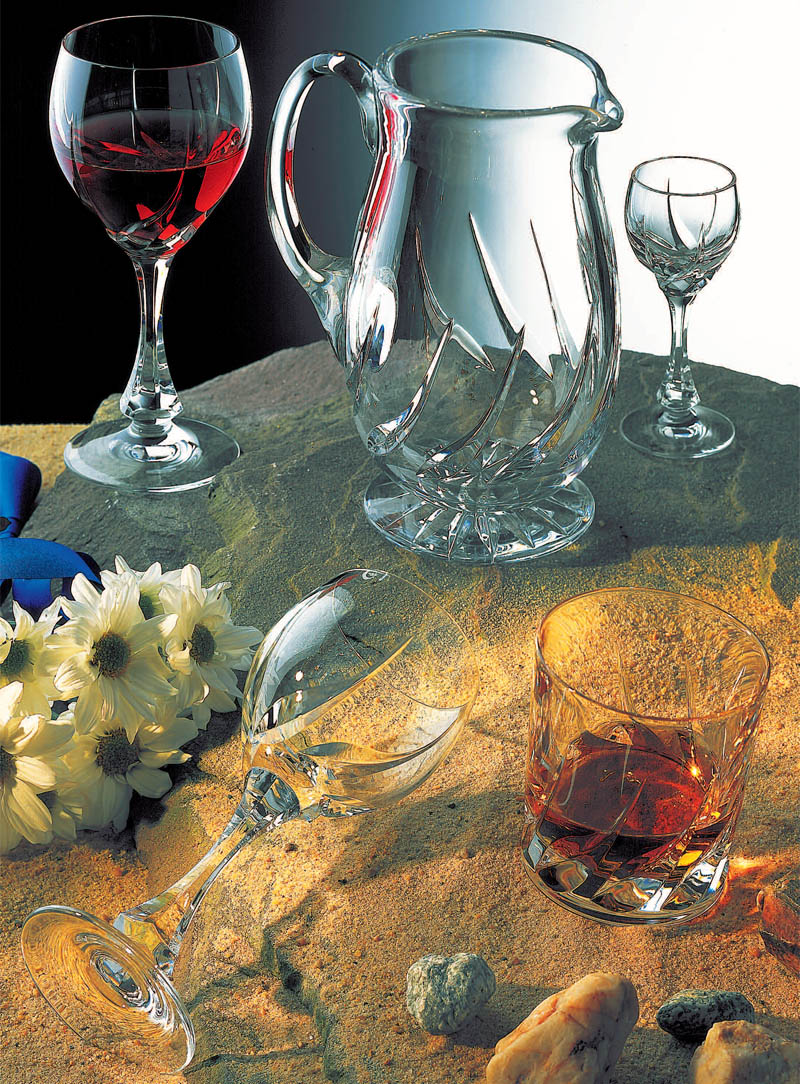
The village of Montbronn, surrounded by the forest of the Northern Vosges, is linked to the tradition of hand-cut glass since the 18th century. Montbronn is home to four crystal works : Montbronn, Ferstler & Fischer, Vosges du Nord and Cristal de Paris.
Leave the village and take the direction of Saint-Louis-lès-Bitche (D36A).
The Saint-Louis crystal works
(211 kms from Nancy)
![The Saint Louis crystal works © Aroche - licence [CC BY-SA 3.0] from Wikimedia Commons](https://frenchmoments.eu/wp-content/uploads/2018/06/Cristallerie-Saint-Louis-©-Aroche-licence-CC-BY-SA-3.0-from-Wikimedia-Commons.jpg)
The Saint-Louis crystal made in Saint-Louis-lès-Bitche is known for being the oldest in France. The glass works of Münzthal was founded in 1586 at a time when the county of Bitche belonged to the Duchy of Lorraine (and therefore was not yet French). In 1767 King Louis XV authorised the activity of a new glass works in the village. In honour of King Louis IX (Saint-Louis) the manufacture received the name of “Royal Glass works of Saint-Louis” (Verrerie royale de Saint-Louis).
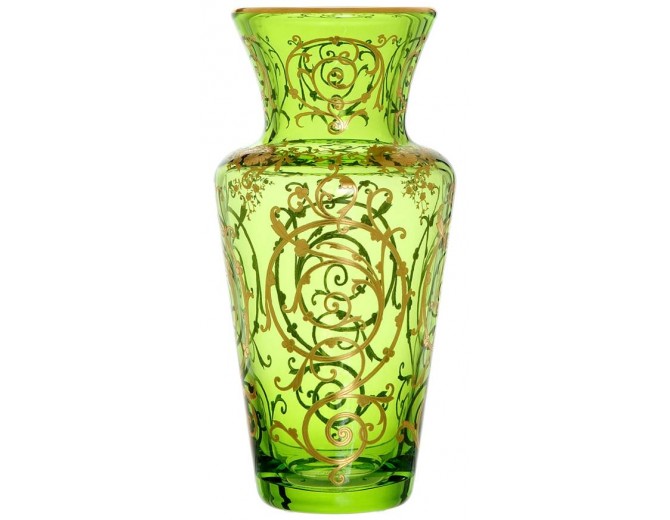
In 1781 the royal glass manufacture unlocked the secret of crystal making which was had been kept by England since 1676. By 1785 Saint-Louis had become the biggest glass works of Europe, followed by the manufactures of Saint-Quirin and Baccarat.
Since 1995 Saint-Louis has been part of the Hermès group.
La Grande Place – The Saint-Louis crystal museum
![The museum of La Grande Place, Saint-Louis © LaGrandePlace - licence [CC BY-SA 3.0] from Wikimedia Commons](https://frenchmoments.eu/wp-content/uploads/2018/06/Le-musée-La-Grande-Place-©-LaGrandePlace-licence-CC-BY-SA-3.0-from-Wikimedia-Commons.jpg)
The Grande Place is the name given to the Saint-Louis crystal museum. It occupies the great hall of the manufacture. The 953 metre-long initiatory tour reveals some 2,000 exceptional pieces of crystal which have been designed by the crystal works for the last four centuries.
Find out more (official website)
Take the D37B until the village of Gœtzenbruck.
The former glass works of Gœtzenbruck
(214 kms from Nancy)
The former glass works of Gœtzenbruck was founded in 1721 by Jean-Georges Poncet, a glass maker from the neighbouring village of Meisenthal. It made hollow glass items, spectacle lenses and laboratory glasses. The manufacture is known for being the origin of a Christmas tradition: the decoration of the tree with glass baubles.
In 1964 the glass works closed its doors. The glass baubles were later redesigned and produced by the Meisenthal International Glass Centre.
Reach Lemberg by the D37.
The former crystal works of Lemberg
(216 kms from Nancy)

A glass works with a sad fate. The Cristallerie Lorraine in Lemberg was founded in 1925 by Théodore Heitzman. The man was a baker which once supplied the neighbouring Saint-Louis crystal works. When the manufacture broke the contract with him, Heitzman decided to open his own crystal works in Lemberg. He hired 20 master glass makers who made a high quality crystal. In the 1930s, the factory employed more than 200 workers. In the 1950s the clients of the Cristallerie Lorraine included Paris’ big department stores: Le Bon Marché, La Samaritaine and the Galeries Lafayette.
Unfortunately the decline in sales combined with stiff competition led to the final shutdown in 1997. The company’s assets were sold at auction in the following two years. The glass site of Meisenthal acquired some 1,000 drawings, sketches and other documents.
Continue the Glass and Crystal Route by taking the D37 until Bitche.
The arrival of the glass and crystal route at Bitche
![The citadel of Bitche © V.degouy - licence [CC BY-SA 4.0] from Wikimedia Commons](https://frenchmoments.eu/wp-content/uploads/2018/06/Citadelle-de-Bitche-©-V.degouy-licence-CC-BY-SA-4.0-from-Wikimedia-Commons.jpg)
By the end of the Glass and Crystal Route, here you are in Bitche.
Don’t miss visiting the imposing citadel of Bitche, a masterpiece of military art by Vauban built in 1683-1697).
From there you can keep discovering the region by choosing from two opposite directions:
- En route to Sarreguemines, with the discovery of the fortifications which are part of the Maginot Line (Simserhof, Fort Casso) and the European archeaelogic park of Bliesbruck.
- En route to Wissembourg, by crossing the Northern Vosges at the border of Germany. Discover many medieval castles: Lutzelhardt, Wasigenstein, Fleckenstein…
Out-of-route: the glass and crystal works of Vannes-le-Châtel
Finally here is another site out beside the Glass and Crystal Route: Vannes-le-Châtel.
Nestled in the Toulois (the region of Toul), the village of Vannes-le-Châtel is a unmissable place for glass art in France. In 1765 a glass factory was established in the neighbouring village of Allamps. In 1960 the manufacture merged with other glass and crystal works (Bayel, Portieux, Vallérysthal and Fains) to become the Compagnie Française du Cristal. It gradually moved from glass to crystal making between 1962 and 1964 and marketed its creations under the brand Cristal de Sèvres. Since then the company has been part of the Daum firm.
The Cerfav of Vannes-le-Châtel

Nowadays Vannes-le-Châtel is home to the Cerfav (European Centre for Glass Art Research and Training). This glass platform is unique in that it offers advances training and diploma-based courses in the techniques and arts of glass. The Cerfav offers guided tours of its workshops which are open to everyone. You can attend a demonstration of glass hand-blowing and visit the training workshops.
Find out more (official website)
Find out more about the Glass and Crystal Route in Lorraine
A selection of websites and blogs :
- The website of Lorraine Tourisme
- The article on the Vessière Brothers (1901-1950), editors and designers in Nancy and Baccarat on the blog Le Verre, le Cristal et la Pâte de Verre [in French]
- The website of the cristallerie Vessière Cristaux where you can find the major collections from Baccarat, Daum and Lalique.
- Read this article in French on the Mon Grand-Est blog.
Did you find what you read interesting? If so, please do share this article on Facebook or twitter! 🙂
Inspired? Pin it for later :


